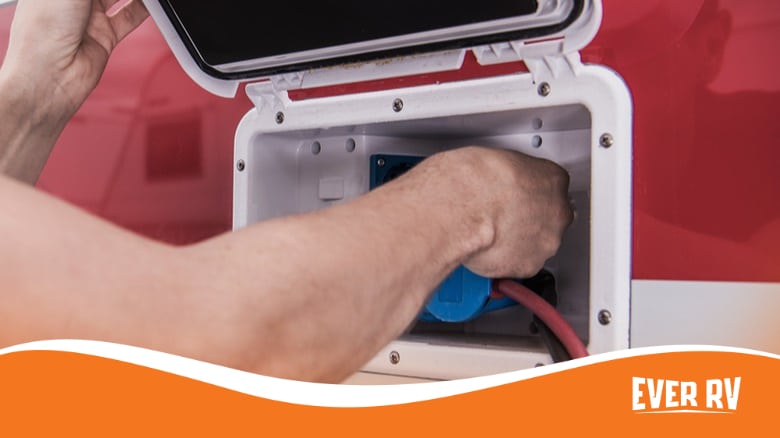The water pressure inside your RV plays a significant role in determining your overall experience. You don’t want the water pressure to be on the higher end, as that might lead to a leakage in the pipe. On the contrary, if the water pressure is too low, it may sabotage basic acts of sanitization and cleaning inside the RV.

Most RV travelers aren’t well versed with the water pressure they should look to achieve inside their RV. In this article, we help guide you towards the right water pressure and make sure that you know what to expect.
Water Pressure for RV
The maximum pressure of the water coming to your RV should be 80 psi. Eighty psi is the recommended water pressure, and anything more than this can damage or destroy your pipes. You can purchase a water pressure gauge easily at an affordable price.
A water pressure gauge will help you determine the exact water pressure inside your RV. Since the RV water tank is located near the faucets and taps, you can easily get the required pressure.
Problems may arise when using water from an external water line near a campsite. The pressure from the external water line may be unregulated and can cause problems. You can regulate the water pressure through a water pressure regulator inside the RV.
Why Do Faucets Leak Due to Pressure?
The faucets inside your RV are meant to handle a specific water pressure. If the water pressure inside the RV exceeds that specific limit, the faucets may start leaking and develop problems.
Leaks and drips from faucets inside the RV kitchen and bathroom can cause wastage of water and accumulation of water inside the RV.
The United States Environmental Protection Agency report has revealed that leaking faucets lead to almost 10,000 gallons of wastage every year. Not only are we incurring massive costs ourselves through these leaky faucets, but by neglecting them, you are also risking damage to your RV fixtures and fittings.
In this section, we mention some reasons behind a leaking faucet. You can either change or replace the faucet once these issues pop up.

The Problem is in The O-Ring
Plumbers often use a stem screw to keep the handle of a faucet in its place. This stem screw usually has a tiny disc attached to it, called the o-ring. The o-ring is often an integral place from where dripping can start in a faucet.
It tends to go loose or wear out with time or with regular use. High water pressure can also cause the o-ring to come out or lose its grip.
This causes the faucet to leak or drip near the handle. The most plausible solution for this issue is to fix the damaged o-ring and get the tap into its original condition. This would stop the leak and mend all problems inside the faucet.
Corroded Valve Seat
A valve seat connects the spout and the faucet in common compression mechanisms. The valve seat is subjected to corrosion because of the accumulation of solid water sediments. If the main water line coming to your house has solid water deposits or sediments, this might corrupt the valve seat.
A corroded valve seat often leads to leakages around the area heading to the spout in a faucet. Regular maintenance jobs from a professional plumber would help keep your valve seat clear of all sediments and any emergency repairs.
Worn out Washer
A worn-out washer is perhaps the most common cause behind a dripping or leaking faucet. Upon extensive use of a tap, the washer inside it is forced against the valve seat, causing friction and ultimately depreciation.
As a result of this friction, the faucet starts to drip along the spout area. A professional plumber can repair a dripping faucet. You can even study some guides online to find out more on how to change a faucet and take out the other.
Type of Faucets to Have in Your RV
As an RV owner, you would like to know that a good tap can make a huge difference. And deciding what to buy from the diverse variety of kitchen faucets is difficult.
Single-Hole Faucets
The most common kind of kitchen faucet we’re sure you might have seen one of these around is a single-hole faucet. Single-hole taps are called this name because they need only one hole to fit in your countertop.
Now, single-hole faucets aren’t meant to be boring like they are projected by many. These faucets have numerous additional features that can be used by many. Their features might be limited because of their design, but they still have adjustable aerators and extra-strength disc cartridges.
Centered Faucets
Also popular as the ‘two-hole’ or the ‘two-handle’ faucets, centered faucets come with two separate handles for cold and hot water. These handles are positioned horizontally to the center spout in a flank-like position.
When it comes to centered faucets, as you might have probably guessed by now, you need multiple holes for the installation process.
Most families prefer these faucets over many others since they come fitted with clear temperature control handles. You don’t have to worry about your kids accidentally meddling with the wrong temperature setting and burning themselves since the distinction has been made extremely clear.
Widespread Faucets
Widespread faucets are similar to center-set faucets. The only dissimilarity is that everything is not connected to a single, unique base plate. When it comes to widespread faucets, individual pieces are installed separately.
The hot and cold water handles are located around 6 to 16 inches from the center faucet spout. The space you choose between the tap and the handles is purely your own decision. See your feasibility, and decide which option is best for you. The difference between the cold and hot handle leads to even more distinction and averts the risk of any anomaly.
Pull-Out Faucets
These faucets are relatively new, and you might not have heard of them yet. Pull-out faucets are precisely similar to what the name suggests. These faucets come with a detachable head that can be pulled out like a hose to bring the spout closer to you.
These faucets are incredibly versatile and help you out with your endeavors in the sink. The detachable hose-like spout makes for added feasibility in the sink.
Using Tankless Water Heaters in RV
Tankless water heaters, also known as on-demand water heaters, provide you with hot water only when you need it. Due to this efficiency, you don’t suffer any energy loss associated with traditional water heaters. Additionally, tankless water heaters can work with the regulated water pressure inside your RV.
How Do Tankless Heaters Work?
The heating process in tankless water heaters is straightforward and efficient. When you turn on the heater, cold water travels through pipes into the tankless unit, where the water is heated by an electrical element or a gas burner. In any case, the supply of hot water is guaranteed when you want it ready.
Since tankless water heaters operate without a tank or an extra unit, they take up much less space than storage water heaters. It has been calculated that an average tankless water heater unit can provide you with roughly 2 to 5 gallons of hot water per minute. Gas-fired tankless water heaters typically have higher flow rates. The space-saving design can work wonders for families inside an RV.
People with large families have also started installing more than one tankless water heater to ensure water for everyone on demand. Considering the energy wastage associated with traditional water heaters, installing two on-demand water heaters is more efficient than installing a storage water heater.
Advantages of Tankless Water Heaters
Besides heating water on demand, there are numerous other benefits associated with tankless water heaters.
Although the upfront cost of a tankless water heater may look higher than conventional storage models, tankless heaters tend to use less energy and last a whole lot longer than the other models.
Many tankless models have been found to last for more than 20 years, which is a significant upgrade to the 10 to 15 years life of other storage heater models. A typical family can save roughly $100 per trip by using tankless water heaters, a considerable saving in enhanced consumption on your RV.
Moreover, since these heaters take up less space, there shouldn’t be anything stopping you from getting one installed in your RV.
Things to Consider Before Installing a Heater in Your RV
We now look at the few things you should consider before installing a water heater in your RV:
Hot Water Needs
One thing you should know before installing a water heater is how much hot water you would need over a specific period. Knowing your hot water needs is imperative for deciding the kind of heater you should install and how big the tank should be.
If you have other people traveling in your RV, you should look for a water heater that can provide sufficient hot water. Once you have established the kind of needs that you might have out of a water heater, you will be able to understand the situation better.
Energy Efficiency
The kind of cash you have on you for paying bills can also define how welcoming you are towards a new water heater type. It would help if you tried looking for water heating alternatives that are easier to maintain and would cost you less in bills.
A solar water heater would perfectly meet the requirements, as it would only take a fraction of the energy that a standard water heater would take. Moreover, by installing a solar water heater, you would also decrease the carbon footprint of the installation. A thorough analysis would eventually help you in making an educated decision.
Size of Water Heater
Finally, you should consider the size of the water heater and only go for an option that can meet the space you have accessible inside your RV. If you have less space around your house, then the perfect choice for you would be, as discussed above, a tankless water heater.
The pressure of water and the plumbing fixtures you use inside the RV is significant to your travel excursions.
We hope you now know the ideal pressure for your RV pipes and the best kind of faucets available on the market today.







